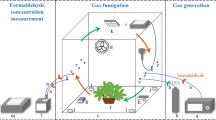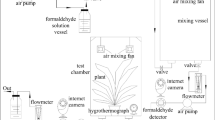Abstract
Formaldehyde is a major indoor air pollutant, and its removal decreases the health risk of urban inhabitants. Scindapsus and Chlorophytum are indoor plants that have been reported to remove formaldehyde. However, their ability to absorb formaldehyde, their resistance, and their morphological changes in response to formaldehyde absorption have not been reported to date. In this study, both Scindapsus and Chlorophytum were used as test materials and their phenotype, microscopic change, enzyme activity, gene expression, and ability to absorb formaldehyde were investigated in response to formaldehyde stress. The results showed that the ability of Chlorophytum to absorb formaldehyde was stronger than that of Scindapsus; moreover, the expression level of the ADH2 gene in Chlorophytum was significantly higher than in Scindapsus. However, Chlorophytum suffered more severe damage of the leaves than Scindapsus. The superoxide dismutase, peroxidase, and catalase enzyme activities of Chlorophytum were lower than those of Scindapsus in response to formaldehyde absorption. This showed that compared with Scindapsus, Chlorophytum had a strong ability to absorb formaldehyde but a weaker ability to tolerate formaldehyde. Based on these results, to purify formaldehyde pollution from indoor air, it is recommended to use the Chlorophytum. However, regular replacement of these damaged Chlorophytum plants should be implemented to retain a beautiful indoor environment.




Similar content being viewed by others
References
Achkor H, Díaz M, Fernández MR, Biosca JA, Parés X, Martínez MC (2003) Enhanced formaldehyde detoxification by overexpression of glutathione-dependent formaldehyde dehydrogenase from Arabidopsis. Plant Physiol 132:2248–2255. https://doi.org/10.1104/pp.103.022277
Agrawal A, Heath AC, Lynskey MT (2011) DSM-IV to DSM-5: the impact of proposed revisions on diagnosis of alcohol use disorders. Addiction 106:1935–1943
Aydogan A, Montoya LD (2011) Formaldehyde removal by common indoor plant species and various growing media. Atmos Environ 45(16):2675–2682. https://doi.org/10.1016/j.atmosenv.2011.02.062
Bontemps S, Sabo-Etienne S (2013) Trapping formaldehyde in the homogeneous catalytic reduction of carbon dioxide. Angew Chem Int Ed Engl 52(39):10253–10258. https://doi.org/10.1002/anie.201304025
Brdarić D, Kovač-Andrić E, Šapina M, Kramarić K, Lutz N, Perković T, Egorov A (2019) Indoor air pollution with benzene, formaldehyde, and nitrogen dioxide in schools in Osijek, Croatia. Air Qual Atmos Health 12:963–968. https://doi.org/10.1007/s11869-019-00715-7
Cruz MD, Christensen JH, Thomsen JD, Müller R (2014) Can ornamental potted plants remove volatile organic compounds from indoor air? Environ Sci Pollut Res 21:13909–13928. https://doi.org/10.1007/s11356-014-3240-x
Dolferus R, Osterman JC, Peacock WJ, Dennis ES (1997) Cloning of the Arabidopsis and rice formaldehyde dehydrogenase genes: implications of the origin of plant ADH enzymes. Genetics 146:1131–1114
European Commission (1994) Environmental chemicals. In: Rossi G, Realini G (eds) Annual Report. Environment Institute. Joint Research Centre, Ispra
Godish T, Guindon C (1989) An assessment of botanical air purification as a formaldehyde mitigation measure under dynamic laboratory chamber conditions. Environ Pollut 61:13–20. https://doi.org/10.1016/0269-7491(89)90092-4
Li FX, Lu J, Xu YJ, Tong ZQ, Nie CL, He RQ (2008) Formaldehyde-mediated chronic damage may be related to sporadic neurodegeneration. Prog Biochem Biophys 35:393–400
Liteplo RG, Meek ME (2003) Formaldehyde: exposure estimation, hazard characterization, and exposure-response analysis. J Toxicol Environ Health B Crit Rev 6(1):85–114. https://doi.org/10.1080/10937400306480
Merk O, Speit G (1998) Significance of formaldehyde-induced DNA-protein crosslinks for mutagenesis. Environ Mol Mutagen 32:260–268. https://doi.org/10.1002/(SICI)1098-2280
Oster U, Tanaka R, Tanaka A, Rudiger W (2000) Cloning and functional expression of gene encoding the key enzyme for chlorophyll b biosynthesis (CAO) from Arabidopsis thaliana. Plant J21(3):305–310. https://doi.org/10.1046/j.1365-313x.2000.00672.x
Panyametheekul S, Rattanapun T, Morris J, Ongwandee M (2019) Foliage houseplant responses to low formaldehyde levels. Build Environ 147:67–76. https://doi.org/10.1016/j.buildenv.2018.09.053
Sakai T, Tanakaa SI, Teshimaa N, Yasudab S, Urac N (2002) Fluorimetric flow injection analysis of trace amount of formaldehyde in environmental atmosphere with 5,5-dimethylcyclohexane-1,3-dione. Talanta 58:1271–1278. https://doi.org/10.1016/S0039-9140(02)00200-X
Swenberg JA, Kerns WD, Mitchell RI, Gralla EJ, Pavkov KL (1980) Induction of squamous cell carcinomas of the rat nasal cavity by inhalation exposure to formaldehyde vapor. Cancer Res 40:3398–3402
Tong X, Wang B, Dai W, Cao J, Ho S, Kwok T, Ka-HeiLui K, Lo C, Ho K (2018) Indoor air pollutant exposure and determinant factors controlling household air quality for elderly people in Hong Kong. Air Qual Atmos Health 11:695–704. https://doi.org/10.1007/s11869-018-0576-2
Wagdi D, Tarabieh K, Zeid M (2018) Indoor air quality index for preoccupancy assessment. Air Qual Atmos Health 11:445–458. https://doi.org/10.1007/s11869-018-0551-y
Wolverton BC, McDonald RC, Watkins EA Jr (1984) Foliage plant for removing indoor air pollutants from energy-efficient home. Econ Bot 38(2):224–228
Xu ZJ, Wang L, Hou HP (2011) Formaldehyde removal by potted plant-soil systems. J Hazard Mater 192:314–318. https://doi.org/10.1016/j.jhazmat.2011.05.020
Zhao XQ, Zhang ZQ (2009) Microwave-assisted online derivatization for sensitive flow injection fluorometric determination of formaldehyde in some foods. Talanta 80:242–245. https://doi.org/10.1016/j.talanta.2009.06.066
Funding
This study was financially supported by the Innovation Scientists and Technicians Troop Construction Projects of Henan Province (C20150054), the Key Scientific Research Projects in Universities of Henan Province (17A210023), and the National Bulk Vegetable Industry Technique System (CARS-23-G18).
Author information
Authors and Affiliations
Corresponding author
Ethics declarations
Conflict of interest
The authors declare that they have no conflict of interest.
Additional information
Publisher’s note
Springer Nature remains neutral with regard to jurisdictional claims in published maps and institutional affiliations.
Electronic supplementary material
Supplementary Fig. 1
Changes of indoor formaldehyde concentration. (PNG 50 kb).
Rights and permissions
About this article
Cite this article
Li, L., Tian, SL., Jiang, J. et al. Differences in purifying and resistance tolerance ability of Scindapsus and Chlorophytum to formaldehyde pollution. Air Qual Atmos Health 13, 501–507 (2020). https://doi.org/10.1007/s11869-020-00814-w
Received:
Accepted:
Published:
Issue Date:
DOI: https://doi.org/10.1007/s11869-020-00814-w




